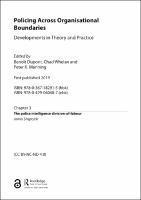Chapter 3 The police intelligence division-of-labour
Proposal review
| dc.contributor.author | Sheptycki, James | |
| dc.date.accessioned | 2019-10-17 13:50:25 | |
| dc.date.accessioned | 2020-04-01T10:21:33Z | |
| dc.date.available | 2020-04-01T10:21:33Z | |
| dc.date.issued | 2019 | |
| dc.identifier | 1005008 | |
| dc.identifier | OCN: 1135845302 | en_US |
| dc.identifier.uri | http://library.oapen.org/handle/20.500.12657/25086 | |
| dc.description.abstract | This article describes the police intelligence division-of-labour. It is argued that police organisation gains overall coherence in relation to the ‘police métier’; a rationale that allows protagonists in the police world to make sense of an irrational workplace structure where personal loyalty, trust and honour (not formal organisational logic) form the basis of action and compliance. The concept of the police métier is defined in terms of the police professional concern with the mastery of surveillance and coercion in the reproduction of order, the making of crime and the governance of insecurity, and it is the polestar of the police mindset. The article describes the police intelligence division-of-labour paying specific attention to four different aspects of intelligence activity: the acquisition of intelligence or information; the analysis of information in the production of intelligence; tasking and co-ordination on the basis of intelligence ‘product’; or being tasked on that same basis. The descriptive analysis presented here is useful in several respects. Firstly it provides a basis for the comparative study of police intelligence work and its configuration within broader processes of security governance. Secondly, it provides a prototypical organisational map useful understanding the orientation of particular units – the organisational elements of policework (e.g. of drug squads, primary response, public order and homicide investigation units) – within the broader police division-of-labour. Lastly, it provides a complex view of issues concerning democratic governance of ‘the police’ as they are configured as nodes within broader networks of security governance. | |
| dc.language | English | |
| dc.subject.classification | thema EDItEUR::J Society and Social Sciences::JP Politics and government | en_US |
| dc.subject.other | police intelligence | |
| dc.subject.other | division of labour | |
| dc.title | Chapter 3 The police intelligence division-of-labour | |
| dc.type | chapter | |
| oapen.relation.isPublishedBy | 7b3c7b10-5b1e-40b3-860e-c6dd5197f0bb | |
| oapen.relation.isPartOfBook | b4d60267-d1c7-482d-b54b-fd53c00c5247 | |
| oapen.relation.isbn | 9780429060687 | |
| oapen.imprint | Routledge | |
| oapen.pages | 17 | |
| oapen.remark.public | 3-8-2020 - No DOI registered in CrossRef for ISBN 9780367182915 | |
| oapen.identifier.ocn | 1135845302 | |
| peerreview.anonymity | Single-anonymised | |
| peerreview.id | bc80075c-96cc-4740-a9f3-a234bc2598f1 | |
| peerreview.open.review | No | |
| peerreview.publish.responsibility | Publisher | |
| peerreview.review.stage | Pre-publication | |
| peerreview.review.type | Proposal | |
| peerreview.reviewer.type | Internal editor | |
| peerreview.reviewer.type | External peer reviewer | |
| peerreview.title | Proposal review | |
| oapen.review.comments | Taylor & Francis open access titles are reviewed as a minimum at proposal stage by at least two external peer reviewers and an internal editor (additional reviews may be sought and additional content reviewed as required). |

